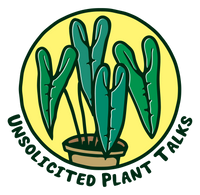Importing Hoyas: Navigating the Road to Successful Delivery and Acclimation

Table of Contents
- Inspect Your Imported Plants
- Hydrate Your Plants
- Prepare the Soil
- Gradually Introduce Them to Light
- Watering Routine
- Repotting
- Be Patient
- Conclusion
For Hoya lovers like us, we know nothing can beat the joy of adding a new plant to your collection. But whether you're a novice or an experienced Hoya parent, importing plants can be a stressful gamble.
Even when your plants arrive healthy, acclimating these new additions to your home environment requires attention and care. But fear not, fellow plant enthusiasts! In this article, we'll journey together, exploring the methods to help your imported Hoyas adapt and flourish in their new home.
By the way, did you know we ship to Canada? Here's what to expect if you're importing from us!
Inspect Your Imported Plants

Ah, the excitement of unboxing a new plant! Whether you've just received a delivery from us at Unsolicited Plant Talks or picked up a green gem elsewhere, the arrival of a new Hoya is a moment of joy. But hold on, dear friend, before you jump into preparations, it's time for a closer look.
Inspection isn't just a matter of procedure; it's an act of care. Whether it's an imported marvel or a local beauty, give your new plant a gentle once-over. Check for signs of unwanted hitchhikers like pests or unexpected diseases.
Here at Unsolicited Plant Talks, we lovingly ensure that each plant leaves our care pest-free and in prime condition. Yet, as meticulous as we are at Unsolicited Plant Talks, the journey to your home can have unexpected twists. When boxes get opened at inspection stations, there's a chance they might mingle with other shipments. Imagine your carefully packed Hoyas in close proximity to other parcels. While inspections are necessary and common, they can sometimes result in boxes being handled less carefully, or even placed near other packages that might harbor pests.
Though we take every precaution to ensure that our plants are pest and disease-free, these inspections can introduce unforeseen risks. Pests can travel from one box to another, making their way to places they were never intended to be. It's a minor but real possibility in the world of plant importation, and one more reason why inspecting your new plants upon arrival is a wise and loving step in their acclimation process.
Your careful inspection is the first embrace for your Hoyas, an assurance that you'll take care of them, come what may. So go ahead, take a closer look, and get to know your new green friend. It's a beautiful way to start a blossoming relationship.
Hydrate Your Plants

After the initial inspection, it's time for a gentle welcome bath. Remove the sphagnum moss from the root ball, and soak your plants in room-temperature water for about 30 minutes to an hour. I strongly recommend adding a plant vitamin called Superthrive during this process. If available, follow the instructions and soak your cherished imports in it for the suggested time. It's a significant step in helping the plant recover from shipping shock and aids tremendously in the acclimation process. Consider it a loving gesture to ensure a smooth transition to their new home.
Prepare the Soil

When it comes to acclimating your imported Hoyas, choosing the right soil is a game-changer. Since most imported plants arrive bare-rooted, you'll want to give them a cozy welcome.
Coco husk is our go-to medium at Unsolicited Plant Talks, and we've seen fantastic success with it! But we've gone a step further; recognizing that coco husks alone can dry pretty quickly, we've crafted a mix that retains moisture a bit longer. This adaptation to our environment ensures that your Hoyas feel right at home, providing a well-balanced mix between moisture retention and root aeration.
If you find the same need for adjustment, you can refer to this blog to see how exactly we mix our medium for Hoyas. This wonderful combination helps to prevent waterlogging or root rot, two things no Hoya parent wants!
Gradually Introduce Them to Light

Our beloved Hoyas are sensitive to light, especially when adjusting to a new environment. If you shock them with intense light, they might just shy away. Start by growing your imported Hoyas in low light. It not only eases their acclimation but helps them divert their energy to reproducing roots, rather than fighting harsh lighting. Slow and steady wins the race here!
Watering Routine

Starting right begins with the perfect balance. Keep your newly potted Hoyas in an open environment where there isn't excessive humidity initially. If high humidity is unavoidable, make sure there's plenty of air circulation to help the leaves dry up a bit. You wouldn't want stagnant water on leaves and stems leading to rot, would you?
Watering your imported Hoyas requires a gentle touch and careful observance. In the beginning, strive for a moist but not sopping wet medium. If your plants are kept in a high humidity environment, watering less often is usually better. This balance between moisture and aeration is key to a smooth acclimation process.
Remember, Hoyas are epiphytes and can drink water from the moisture in the environment. By understanding their needs and being mindful of the specific conditions they're in, you'll be nurturing them in the best possible way. It's not just about pouring water; it's about creating a harmonious new home for these exotic beauties.
Repotting

When it comes to repotting acclimating Hoyas, one size doesn't fit all, and sometimes it's unnecessary to repot right away.
Here at Unsolicited Plant Talks, we cherish the coco husk for both acclimation and as a permanent residence. And it might just work wonders for you too! But if you're considering a change, it's best to wait for a robust root system to develop. If you notice that the plants' roots have taken over the medium and you find yourself watering your Hoya more often, this means the medium has become too small for the plant, and it is now ready for a new or bigger pot.
Every Hoya is different, and there's no strict timeline to follow. The secret? Observance. Keep a watchful eye on your Hoyas and let them guide you to the perfect moment for repotting if needed. Patience and attentiveness will ensure that your precious Hoyas continue to thrive in their new environment.
Be Patient

Patience is more than a virtue; it's a necessity when acclimating imported Hoyas. The size of the plant matters, as a Hoya with multiple nodes and leaves will take longer to settle than a single-node cutting. So give them time, observe, and embrace the journey. Your Hoyas will eventually bloom and grow, reflecting all your love and care.
Conclusion

Acclimating imported Hoyas may seem like a delicate dance, but with these guidelines and your attentive care, they'll thrive beautifully. Whether it's preparing the right soil mix with coco husk, introducing them gradually to light, or mastering the watering routine, you've got what it takes to make your Hoyas feel at home. Just remember, patience, and understanding of your specific plant's needs will guide you to success. Happy Hoya parenting!





